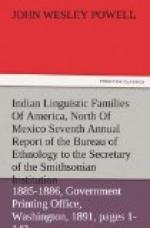ILLUSTRATION
Plate I. Map. Linguistic stocks of North America north of Mexico. In pocket at end of volume
[Transcriber’s Note:
The Map is available in the “images” directory
accompanying the html
version of this file. There are two sizes in
addition to the thumbnail:
mapsmall.jpg: 640x788 pixels (about
9x11 in / 23x28 cm, 168K)
maplarge.jpg: 1598x1971 pixels (about
22x27 in / 56x70 cm, 1MB) ]
* * * * *
Indianlinguistic families.
By J. W. Powell.
* * * * *
Nomenclatureof linguistic families.
The languages spoken by the pre-Columbian tribes of North America were many and diverse. Into the regions occupied by these tribes travelers, traders, and missionaries have penetrated in advance of civilization, and civilization itself has marched across the continent at a rapid rate. Under these conditions the languages of the various tribes have received much study. Many extensive works have been published, embracing grammars and dictionaries; but a far greater number of minor vocabularies have been collected and very many have been published. In addition to these, the Bible, in whole or in part, and various religious books and school books, have been translated into Indian tongues to be used for purposes of instruction; and newspapers have been published in the Indian languages. Altogether the literature of these languages and that relating to them are of vast extent.
While the materials seem thus to be abundant, the student of Indian languages finds the subject to be one requiring most thoughtful consideration, difficulties arising from the following conditions:
(1) A great number of linguistic stocks or families are discovered.
(2) The boundaries between the different stocks of languages are not immediately apparent, from the fact that many tribes of diverse stocks have had more or less association, and to some extent linguistic materials have been borrowed, and thus have passed out of the exclusive possession of cognate peoples.
(3) Where many peoples, each few in number, are thrown together, an intertribal language is developed. To a large extent this is gesture speech; but to a limited extent useful and important words are adopted by various tribes, and out of this material an intertribal “jargon” is established. Travelers and all others who do not thoroughly study a language are far more likely to acquire this jargon speech than the real speech of the people; and the tendency to base relationship upon such jargons has led to confusion.
(4) This tendency to the establishment of intertribal jargons was greatly accelerated on the advent of the white man, for thereby many tribes were pushed from their ancestral homes and tribes were mixed with tribes. As a result, new relations and new industries, especially of trade, were established, and the new associations of tribe with tribe and of the Indians with Europeans led very often to the development of quite elaborate jargon languages. All of these have a tendency to complicate the study of the Indian tongues by comparative methods.




